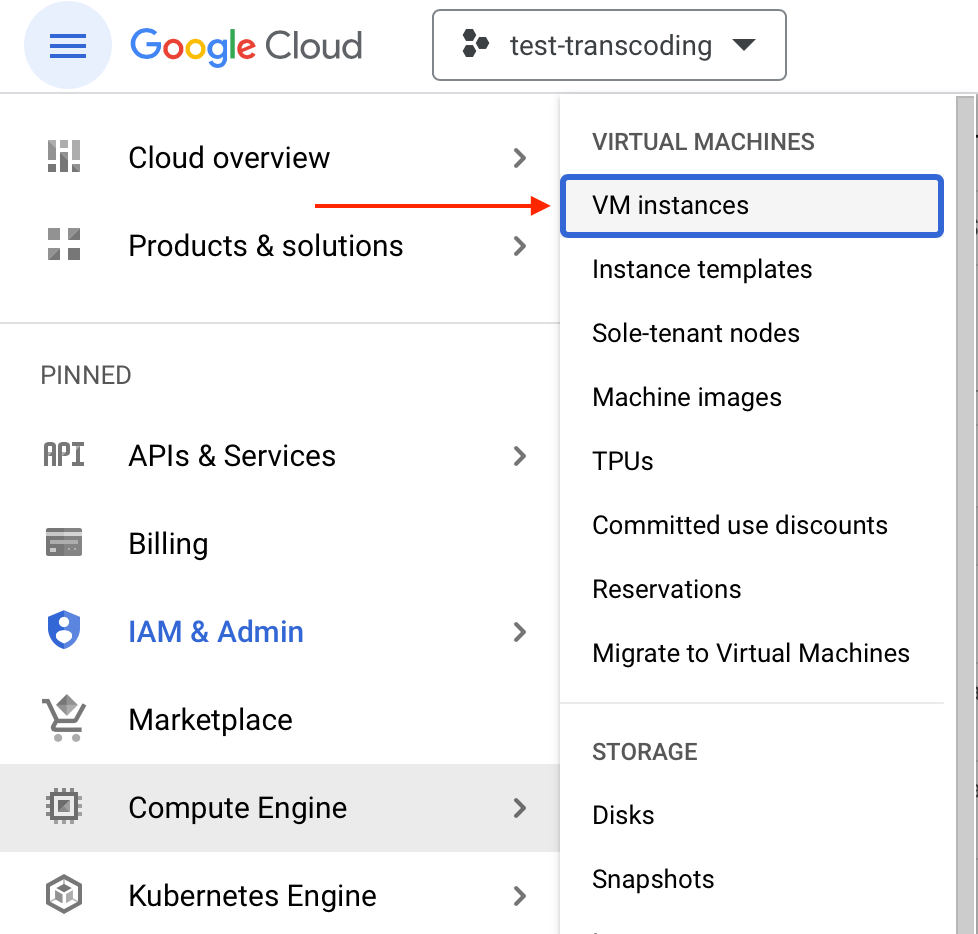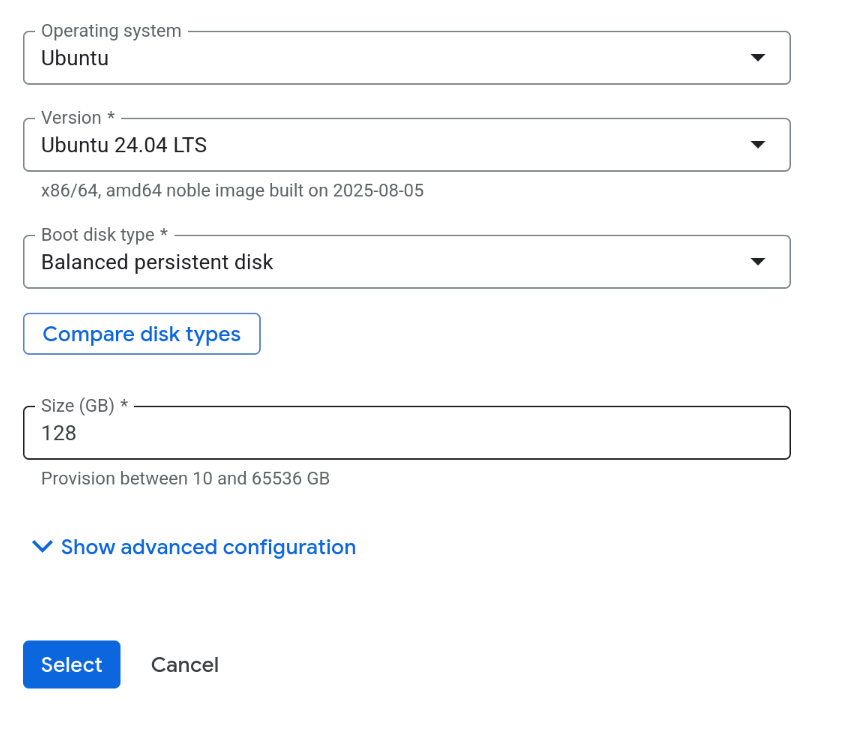Launch host instance
This page will guide you through the creation of VM instance page on Google Cloud.
Configuring the instance
Navigate from the Google Cloud dashboard to Compute Engine and find VM Instances.

Click on Create instance button located at the top of the page.
Name and region
Specify the name of your instance and the designated region in which the instance should be hosted.
Machine configuration
GPU selection
In this section, switch the instance type from General purpose to GPUs. Then list from GPU type drop-down menu and select any of the listed GPUs.
CPU selection
You can list from available CPU + RAM combinations and select one or, preferably, switch to Custom to adjust the number of vCPUs and amount of RAM by yourself.
HW availability
- The availability of HW configurations is different across various regions. If your configuration is not available in the specified region, you will be notified and offered an alternative region.
- Always watch your quotas - the configuration page won't notify you whether the HW specs are within your quotas, e.g. it won't check whether you can create an instance with 64 vCPUs and four GPUs Tesla T4. HW specs and quotas are evaluated once you hit Create button.
HW recommendationWe recommend starting your testing with the n1-standard-8(8vCPU,30GB memory) instance..
Still don't know what HW configuration is best suitable for you? Don't worry, our team will gladly help you out. Contact us at [email protected] and describe your workflow for us.
Boot disk
The recommended host OS for Live Transcoder is Ubuntu 24.04 LTS. You can select it by clicking on Change button in the Boot disk section.
For hourly-based streaming (less than 40 hours a month), the capacity of 128 GB will suffice. For HLS streaming (you can check our storage calculator) or more extended streaming periods, you should increase the storage size to at least 256 GB.
Make sure to check the Delete boot disk in Advanced configuration options so your quotas for disk space won't get filled up by deleted instances.

When using an instance with a smaller storage capacity, it is important to note that a significant portion of the free space is used for storing log messages in the journal. These log messages are crucial for diagnostics. Insufficient space for the journal can limit the ability to diagnose issues with the instance effectively.
To manage disk space efficiently, ensure you set the correct size forSystemKeepFree=andRuntimeKeepFree=in/etc/systemd/journald.conf.
Firewall
It is mandatory to allow HTTP traffic to be able to
- Access the GUI to the Live Transcoder
- Receive an HLS stream or host the HLS output
Allowing HTTPS is mandatory only if your HLS sources are on secured HTTP.
Advanced options
Networking
All the necessary networking/firewall rules are set for a particular network, usually labeled as default, before or after the instance is created. You will find an example of firewall rules later in the guide.
Management
Find the Automation section and paste the following script in it:
#!/bin/bash
# log file for nvidia-smi output executed in docker via NVIDIA container toolkit (NTC)
NTC_NVSMI_OUTPUT_FILE="nvidia-smi-docker.log"
# and log docker-compose version
DOCKER_COMPOSE_V="docker-compose-version.log"
# if these files exist, the system preparation has been performed
# do not continue if any of them exist (the preparation might have terminated abruptly)
if [ -f ${NTC_NVSMI_OUTPUT_FILE} ] || [ -f ${DOCKER_COMPOSE_V} ] ; then
exit 0;
fi
# disable nouveau
sudo modprobe -r nouveau
echo "blacklist nouveau" | sudo tee /etc/modprobe.d/blacklist.conf
# update the system and install nvidia packages
sudo apt-get update -y
sudo apt install -y nvidia-headless-535 nvidia-utils-535 libnvidia-encode-535
sudo modprobe nvidia
# download and enable docker
curl https://get.docker.com | sh && sudo systemctl --now enable docker
# subscribe to NTC repo
curl -fsSL https://nvidia.github.io/libnvidia-container/gpgkey | sudo gpg --dearmor -o /usr/share/keyrings/nvidia-container-toolkit-keyring.gpg \
&& curl -s -L https://nvidia.github.io/libnvidia-container/stable/deb/nvidia-container-toolkit.list | \
sed 's#deb https://#deb [signed-by=/usr/share/keyrings/nvidia-container-toolkit-keyring.gpg] https://#g' | \
sudo tee /etc/apt/sources.list.d/nvidia-container-toolkit.list
sudo apt-get update
export NVIDIA_CONTAINER_TOOLKIT_VERSION=1.17.7-1
sudo apt-get install -y \
nvidia-container-toolkit=${NVIDIA_CONTAINER_TOOLKIT_VERSION} \
nvidia-container-toolkit-base=${NVIDIA_CONTAINER_TOOLKIT_VERSION} \
libnvidia-container-tools=${NVIDIA_CONTAINER_TOOLKIT_VERSION} \
libnvidia-container1=${NVIDIA_CONTAINER_TOOLKIT_VERSION}
sudo nvidia-ctk runtime configure --runtime=docker
sudo systemctl restart docker
sudo docker run --rm --runtime=nvidia --gpus all nvidia/cuda:11.6.2-base-ubuntu20.04 nvidia-smi > ${NTC_NVSMI_OUTPUT_FILE}
# setup docker-compose
sudo curl -L https://github.com/docker/compose/releases/latest/download/docker-compose-$(uname -s)-$(uname -m) -o /usr/local/bin/docker-compose
sudo chmod +x /usr/local/bin/docker-compose
docker-compose version > ${DOCKER_COMPOSE_V}This script installs all necessary packages, docker, docker-compose, and NVIDIA container toolkit for your convenience.
Check the OS compatibilityMake sure you selected Ubuntu 24.04 LTS as an Operating system, as the script is being tested and maintained against this operating system only.
With this configuration, you can finally Create the VM Instance and continue by setting up Firewall rules.
Firewall rules
Navigate from the Google Cloud dashboard to Compute Engine and find VM Instances.
Select the Set up firewall rules option.

There is already a set of rules for your default network which allows you to freely send/receive data between the instances on this particular network.
To allow ingress and egress traffic with world, you have to click on Create firewall rule.
Next up:
- Type in the rule's Name
- (Optional) Associate the rule with a particular Network
- Select Direction of traffic
- Target tags to apply the rule only for certain VM instances in the network, or select All instances in the network from the drop-down menu
- Specify the Source/Destination IPv4 ranges, port range, and protocol
Note that you must specify these rules for ingress and egress traffic separately by creating 2 firewall rules.
NDI, SRT and RTMP firewall rulesTo allow a network traffic ingress or egress for these protocols, you have to enable traffic via specific TCP and UDP ports, e.g.:
- NDI - Allow TCP and UDP ports in range 5353-7999, as described in NDI documentation
- SRT (incl. RTP/UDP) - Allow specific range for UDP ports for your MPEG-TS streams in/out, e.g. port range 5000-6000
- RTMP - Allow TCP port 1935
Updated about 2 months ago
In next section you will learn how to set up your host instance - install CUDA and NVIDIA container toolkit as well as start a docker container with Live Transcoder.
